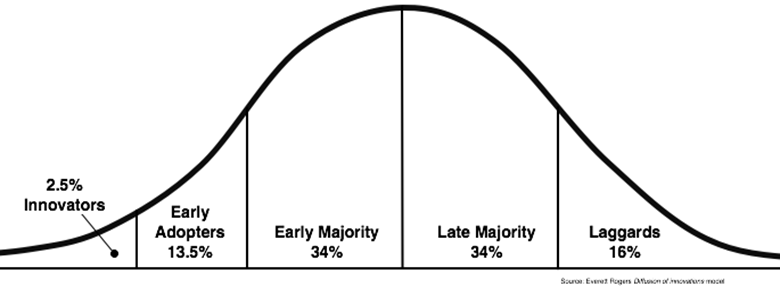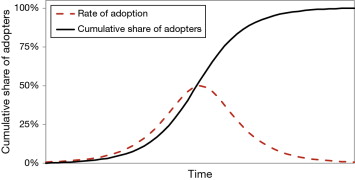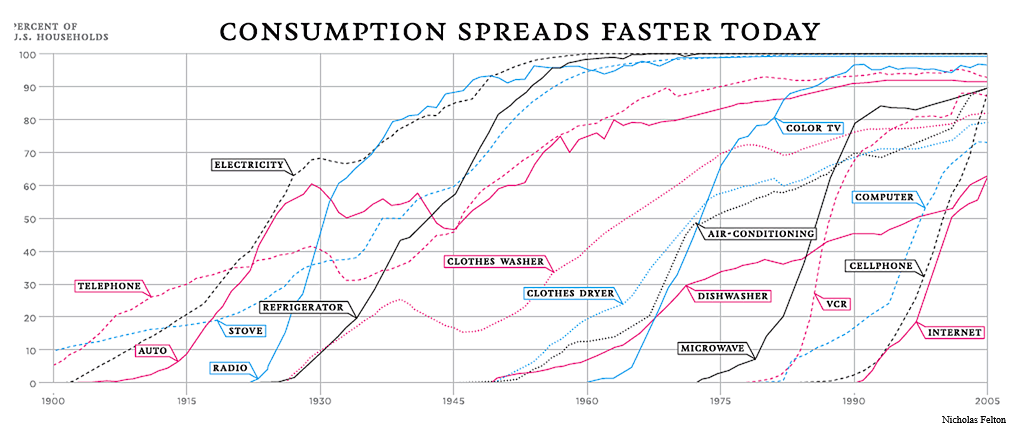The growth of solar energy has exploded in the past few years. According to Our World in Data, solar’s share of global electricity production jumped from 0.15% percent in 2010 to over 4.52% in 2022.1 This has left even the most optimistic solar adoption predictions in the dust. And everyone from skeptical naysayers to the loudest cheerleaders have been taken by surprise. In a 2012 Harvard Business School paper, researchers referred to solar as “the most expensive renewable energy.”2 Compare that to about a decade later where we’re entering solar’s “terawatt age.” The sun is now widely regarded as the cheapest way to generate electricity.34 If there were ever a time to get in on solar, it would be now.
So, how did we get here? How on earth did the industry manage to pull this off? And more importantly…why were everyone’s predictions, both for and against solar, so wrong?
Solar’s successful transformation into an accessible, clean source of energy is a big jump from its previous reputation as a too expensive fossil fuel alternative. In 2010, fossil fuel power plants represented about two-thirds of newly built electricity in the U.S. In 2022, solar now makes up half of all power capacity added to the grid, with another quarter going to wind. Only about 17% went to nonrenewables.5 On top of that, last year solar deployment beat out new installations of every other power source combined.6
I could throw statistics about solar’s rocket-like ascension at you all day. But maybe one of the most relevant figures to hit the latest headlines is that according to the IEA, solar is on track to beat out fossil fuel investment this year. Only five years ago, the ratio of money spent on fossil fuels to renewables was about one-to-one. These days, though? In the words of IEA’s executive director, Faith Birol:
“For every dollar invested in fossil fuels, about 1.7 dollars are now going into clean energy.”78
Considering solar’s extensive history of being sidelined for fossil fuels that were cheaper in the short-term, this is amazing progress.29 In the long run, however, the rate of solar adoption is just like any other form of technology for two main reasons. To fully understand why, we’ll have to take a step back into the past…and the cornfields of Iowa.
The year is 1962, and it’s an exciting time for both science … and the science of science. Thomas Kuhn publishes “The Structure of Scientific Revolutions,” which introduced the concept that would evolve into what we now know as a “paradigm shift.”10 The first use of the phrase “personal computer” appears in a New York Times article titled “Pocket Computer May Replace Shopping List.”11 And Everett Rogers popularizes the adoption curve model in his book “Diffusion of Innovations.”12
You might have heard about adoption curves before, but in case you haven’t, here’s a quick rundown. The seminal investigation that led to the development of the Diffusion of Innovations framework was about none other than trendy crops. In the 1940s, Iowa State University sociologists Bryce Ryan and Neal C. Gross studied how long it took for local communities to start planting hybrid seed corn. Agricultural researchers released the product in 1927, and a bit over a decade later, virtually every farmer in the state was shucking the stuff. Ryan and Gross sought to determine how the practice spread, and in the pair’s 1943 study, they noted that what they called “the diffusion pattern” of the corn’s rate of adoption had three stages. First, there was a “long period of slow initial growth,” then a “rapid rise in adoption,” and finally “a brief decline as the most resistant adopters accepted the technique.”13
If that sounds familiar, it’s because Rogers built upon these observations. In fact, his own father was a “resistant adopter” who didn’t use the newfangled corn. Rogers collaborated on the diffusion research, and eventually he developed a mathematical means of expressing rates of adoption, an S-shaped curve that looks like this:1415


The cumulative number of growers using hybrid seed corn followed this sigmoid curve, the same way things have shaken out with pretty much any major technological upheaval you can imagine.12 And as time passes, these slopes have only ever been getting steeper and steeper. Here’s a famous graph by designer Nicholas Felton, which was originally featured in a 2008 New York Times piece. Even with the data ending in 2005, you can see how adoption curves have progressively gravitated toward a practically vertical incline.1617

So, since the ‘60s, researchers from all fields…not just ones filled with corn…have applied Diffusion of Innovation theory to everything from promoting healthy habits to selling software.1819 And the popularity of using solar power to generate electricity, like many other ideas, happens to be a quintessential example of how adoption curves work.
Human psychology is the first reason why Rogers’ theory is so relevant to solar. But if we wanted to start all the way to the left side of the curve and thoroughly discuss solar innovators, we’d be traveling back thousands of years to the days of ancient China and Greece, when the orientation of the sun was a crucial consideration in architecture. The reason why is kind of funny. Same as us — to save money on utility bills.9
However, as fascinating as the history of solar energy is, we only need to look into the recent past to get a sense of its rise. As recently as the 2010s, interest in solar was waning. Its economics were failing, and oil companies like Shell and BP — some of solar’s most significant supporters — began to divest from the technology.2
Shell’s chief executive put it this way in 2010:
“…We are prepared to invest in Research & Development, including in alternative energies. But our activities need to give us profitability. We’re a company like any other and we need to make a profit in order to exist.”2
The next year, BP Solar shut down, with the company also declaring the division unprofitable.20 Then, Suntech, one of the world’s largest solar manufacturers, went bankrupt in 2013.21
In that 2012 paper I mentioned earlier, Harvard researchers wrote that “solar energy has never lived up to the potential which its adherents claimed.”2
That hurts.
Of course, not everyone lost faith in the technology. In 2010, the environmentalist group Greenpeace estimated that the world would install about 335,000 MW of solar by 2020, which represented a 737.5% increase.22 The organization, despite its high hopes, was very, very wrong…in the best possible way. By 2021, we broke into terawatt territory in terms of installed capacity instead.23
Meanwhile, the International Energy Agency assumed in the 2010 edition of its World Energy Outlook report that photovoltaics would drop in cost from more than $350 per MWh to just over $200 per MWh by 2020.24 However, right now the global weighted average levelized cost of energy or LCOE is sitting at about $120 per MWh … with energy storage … and about $50 per MWh without.4 It’s kind of insane.
To put solar’s intense price drops into a consumer’s perspective, it would cost you over a million dollars to install an average sized rooftop solar panel system on a home back in 1975, with each PV module priced at about $115 per watt. By 2010, the cost per watt effectively started to flatline. And as of 2021, modules go for about $0.27 per watt, and the average U.S. homeowner spends roughly $20,000 on a rooftop solar system.5 Not to mention the prices of rooftop systems are way lower in countries like Australia and Germany, and have been for a while now.25
What does this have to do with adoption curves? Well, the general public has known about the dangers of climate change as early as the ‘50s.26 It’s also been common knowledge that solar can provide an inexpensive means of producing power since the late 19th century. For example, in 1874, French inventor Augustin Mouchot finished his design of one of the earliest solar devices, which could drive a steam engine.9
Here’s where Rogers comes in. His work can offer some clarity as to the psychological reasons behind solar’s popularity (or lack thereof). There’s five major attributes of innovations within Diffusion of Innovations theory, and relative advantage seems to be the one that has knocked solar the most. Innovations that are preventative in nature, like renewable energy tech, are inherently less attractive because there’s no immediate, or sometimes even visible, payoff.1827
When an idea is introduced to people for the sake of reducing the chances of a bad thing happening, rather than to produce a fortunate outcome, people tend to be less interested. This is just as much a problem with climate change education as it is when advocating for limited consumption of red meat or avoiding smoking — any public health official can tell you that.1827
And several times throughout history, the feasibility of solar has been investigated for the precise purpose of averting or mitigating fuel crises. Mouchot’s motivation? Finding an alternative to coal, which France had no choice but to import. He was concerned about the supply one day running out. Similar worries propelled Swedish-American inventor John Ericsson, who also built a solar steam engine within a few years of Mouchot.9
Now we’ve covered the sociological factors that influenced solar’s adoption curve, but what else stopped solar from catching on earlier? You probably don’t need me to tell you: money. Solar worked — but it was an investment. In the days of Ericsson and Mouchot, solar pumps cost anywhere from two to five times more than a conventional power plant. The eventual payback and elimination of fuel costs just wasn’t enough of an advantage to edge out steam. In an eerie prediction near his death, Ericsson wrote: “until the coal mines are exhausted, the value of solar will not be fully acknowledged.”9 Such is the curse of a low relative advantage.
And so, high upfront costs continued to scare off generations upon generations of would-be solar adopters. It played out the same way with solar power plants in the early 1900s and the solar water heater industries of the ‘20s, ‘30s…and ‘60s. Across borders and over multiple eras, whenever the price of coal, natural gas, or oil dropped, sales in sun-powered tech plummeted, too.9
Solar was firmly stuck. How did it get unstuck?
As it turns out, Rogers also has an answer for that. Another component of Diffusion of Innovations theory is the notion of “critical mass.” When an innovation reaches critical mass, the struggle of selling to someone who isn’t buying effectively disappears. Its spread no longer needs to be helped along. The snowball has rolled into an avalanche.27
We’ve all experienced critical mass at some point in our lives, whether it was the transition from landlines to cell phones, the evolution of cell phones into smartphones, or the proliferation of social media.19 It’s also worth noting that as an innovation approaches critical mass, each new person that joins the wave adds to its value for future adopters.27
This can happen in reverse, though, and it’s evident in the boom-bust cycles of past solar ventures. When someone is under the impression that other people are abandoning an innovation, you get a domino effect that threatens its survival. No doubt this phenomenon had a role in the end of any previous solar heyday…and that’s why you can find solar water heaters in the state of Florida that are a century old. After World War II, the electricity prices that residents skirted with solar finally went down, and obtaining hot water from the sun wasn’t practical … or hip.279
What factors keep this from happening? There are multiple paths that lead to critical mass, but one stands out for solar: incentives. Rewarding early adopters allows innovations to inch up the curve until they pass the threshold of critical mass.27 We can see this clearly in the influence of feed-in tariffs implemented by China, Germany, and Japan. By encouraging the production of renewable energy over the course of the past few decades, these countries are now…ahead of the curve. As of 2022, China has emerged as the top photovoltaics market, Germany is in the top three in terms of solar PV watts per capita, and Japan is fourth in the world in total amount of solar capacity.2829
That’s why defanging programs like net metering is so destructive to the renewable energy transition. Without incentives to encourage early adoption by those who can afford to take risks and absorb high upfront costs, any technology is susceptible to losing momentum. I have an entire video about the consequences of the misconception that incentivizing solar rooftops is unfair, so if you’re interested in learning more about that, be sure to check it out.
With this understanding of history and science in mind, it should come as no surprise that the United States’ passage of the Inflation Reduction Act has given solar’s credibility a big boost. You can take it straight from the industry side: In February, Aurora Solar conducted a survey of 898 solar professionals in the U.S. Of the respondents, over 45% of solar installers credit the IRA with increased interest in solar. Another 40% expect this solar star power to increase in the future.30
Meanwhile, when the Swiss solar module manufacturer, Meyer Burger, announced its new U.S.-based factory last July, they cited the IRA and Colorado’s generous tax incentives as the reason why.3132 So, the U.S. institutes a bunch of tax incentives and suddenly, solar’s one of the cool kids again. Funny how that’s the same way it’s worked everywhere else. According to pv magazine, 69% of the world’s solar is currently concentrated in China, the US, Japan, Germany, and India.33
In the end, the solar’s advancement from fringe to fashionable is wonderful, but predictable. It’s always been about money…and human psychology. Scientists have also always struggled with the difference between what people know and what people do. There’s actually a term for it: the “value-action gap” or “knowledge-attitudes-practice gap.” And lack of movement toward protecting ourselves and the environment are classic conundrums.2718 Behavior change is a tough sell. Quick and easy solutions — especially those backed by governments — are not. Same as it ever was.
- Electricity Mix ↩︎
- “Power from Sunshine”: A Business History of Solar Energy ↩︎
- Photovoltaics module reliability for the terawatt age ↩︎
- Solar will be in “unassailable position” as cheapest source of electricity ↩︎
- The Remarkable Growth of Solar Power, in 7 Charts ↩︎
- Despairing about climate change? These four charts on the unstoppable growth of solar may change your mind ↩︎
- Solar investment set to overtake oil production and attract over $1 billion a day in 2023, IEA says ↩︎
- World Energy Investment 2023 ↩︎
- Let It Shine: The 6,000-Year Story of Solar Energy ↩︎
- Thomas Kuhn: the man who changed the way the world looked at science ↩︎
- Pocket Computer May Replace Shopping List; Inventor Says Device Could Tell Grocery in Advance What Customer Needs ↩︎
- Diffusion of Innovation ↩︎
- Acceptance and diffusion of hybrid corn seed in two Iowa communities ↩︎
- Diffusion of Innovation Theory ↩︎
- Everett M. Rogers ↩︎
- Consumption Spreads Faster Today ↩︎
- The Pace of Technology Adoption is Speeding Up ↩︎
- Diffusion Theory ↩︎
- Adoption Curves ↩︎
- BP Will Close its Solar Division ↩︎
- Suntech Won’t Object as China Banks Seek Solar Bankruptcy ↩︎
- The Rise of Solar Power ↩︎
- Humans have installed 1 terawatt of solar capacity, generated over 1 petawatt of solar electricity in 2021 ↩︎
- World Energy Outlook 2010 ↩︎
- Why Are Residential PV Prices in Germany So Much Lower Than in the United States? ↩︎
- Climate change first went viral 70 years ago ↩︎
- On the Diffusion of Innovations: How New Ideas Spread ↩︎
- Feed-In Tariff (FIT): Explanation, History and Uses ↩︎
- Snapshot of Global PV Markets ↩︎
- Solar Industry Snapshot ↩︎
- Meyer Burger Announces Solar Cell Production Facility in Colorado, USA ↩︎
- Is the EU doing enough to establish a solar manufacturing supply chain? ↩︎
- Building to last in the Global South ↩︎















Comments